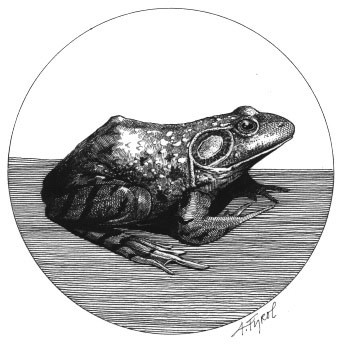
One summer night, in the light of a half moon, I saw a bullfrog trespass on another’s territory. The owner met the challenge full force. Eight times he inflated his lungs and guts, then leaped in the air, erect and bloated. A jolly shoving match ensued, with both squat frogs bouncing and grappling like sumo wrestlers. To the victor–in this case the larger frog and resident landowner–went the spoils: the more prominent calling site.
Sometimes if the losing male is small and careless, he may himself become part of the spoils and wind up in the belly of his assailant.
A female bullfrog must be equally careful when selecting a mate. If she chooses a male that exceeds her size (bullfrogs may grow to be eight inches from nose to vent), she may end up defending herself rather than mating. The prudent female gauges the size of her suitor by the depth and resonance of his voice, approaching only those males whose dimensions seem compatible with her own.
The wetland near our house, which exceeds 70 acres in size, supports perhaps a dozen calling males. They begin their serenade in late afternoon, when the water temperature is close to 70 degrees Fahrenheit, and continue calling throughout the night. Each “jug-o-rum” of the bullfrog carries more than a quarter mile. But for all their power and aggression, bullfrogs are cautious beasts; when I’m observing them, they always wait for me to stop moving before re-broadcasting their intentions.
Bullfrogs attach their eggs to submerged vegetation in June and July. Because the water is warm, embryonic development is quick, and the tadpoles hatch in less than two weeks. By the time bullfrog eggs hatch, spring peepers have long since left the water to join wood frogs on the forest floor, gray treefrogs have returned to the trees, and American toads are back in the garden.
The tadpoles of bullfrogs, which grow to more than six inches in length, may take three summers to develop into froglets. When metamorphosis is complete, herds of these small bullfrogs station themselves along the shoreline and wait for unsuspecting aquatic insects–dragonflies, mayflies, water striders, water boatmen–while attempting to avoid the cavernous mouths of their parents.
Of all our local amphibians, the adult bullfrog has the most varied diet. Any animal that can fit into its mouth is suitable food. So great is its appetite that a bullfrog can be thought of as a mouth and stomach propelled by huge hind legs. I have dissected bullfrogs and found their stomachs crammed with baby painted and snapping turtles, crayfish, dragonflies, and other frogs. It makes no difference whether it’s a wood frog or peeper, American toad or gray treefrog, or even a newly minted bullfrog; if it moves and if it’s small enough, it’s eaten.
I once watched a moderately sized bullfrog stuff a full-grown green frog in its mouth. For ten minutes, the green frog struggled, its feet flailing from the bigger frog’s mouth, until, tired and deprived of air, it relaxed, disappearing down the cavernous void. As soon as the bullfrog forced down its lunch, it stationed itself by the shoreline and waited for another victim.
Even barn swallows and cliff swallows, which go to the shore to collect mud for their nests, and swamp sparrows, which stalk through the reeds, may wind up in the belly of a bullfrog. Unsuspecting hummingbirds sipping nectar from blossoms of jewelweed and cardinal flower are caught; so are meadow voles, water shrews, ducklings, and mid-sized snakes.
I know of no other animal whose voice, relative to its size, projects as far as that of the bullfrog’s. Many years ago, I lived in a cottage next to a small millpond that was full of bullfrogs. Every evening the males climbed up on small boulders that were scattered around the shallows, one frog to a rock, and filled the night with their deep calls. From a distance they sounded like a roll of thunder, it was so deafening.
But I was not the only one tuned to their clamor. A pair of barred owls regularly perched on snags and hunted the frogs. In the morning, a red-shouldered hawk took over. A family of raccoons and an itinerant otter also used the pond as their larder and drove the frogs, leaping and squealing with terror, into the depths of the pond. American bitterns and mink also take their toll of bullfrog tadpoles and froglets.
In the case of the resident bully, the turn-about somehow seems justified.


Discussion *